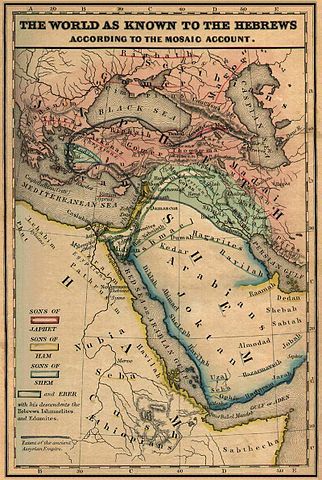
Ashkenaz is shown in Phrygia in this 1854 map of “The World as known to the Hebrews” (Lyman Coleman, Historical Textbook and Atlas of Biblical Geography) | (c) en.wikipedia.org/wiki/Ashkenaz
Today, we will delve into the intricate dynamics of Jewish life within the medieval feudal society. In this article, we will examine the corporate nature of medieval society and explore the intriguing question of where Jews fit into this hierarchical structure. Join us as we uncover the role of Jews in Ashkenaz and their unique position within a system primarily defined by kings, nobles, and peasants.
Embark on remarkable Jewish heritage tours to delve deeper into our shared history by joining us on a kosher riverboat cruises provided by Kosher River Cruises. Indulge in elegant travel, savor exquisite kosher dining, and partake in daily services. Immerse yourself in splendid destinations while enjoying luxurious accommodations onboard. Elevate your vacation experience to extraordinary heights with this exceptional Jewish getaway.
Understanding Medieval Feudal Society
To comprehend the Jews’ place in medieval society, it is crucial to grasp the corporate or feudal nature of the era. Unlike modern societies, where individuals directly relate to the governing authority, medieval society operated on a system of mutual relationships within various groups. These groups, akin to castes or classes, had distinct responsibilities, privileges, and interdependencies.
The Feudal Hierarchy
At the apex of medieval society stood the king, followed by a hierarchy of nobles comprising dukes, counts, and others. The lower stratum consisted of peasants or serfs, forming the vast majority, while the nobles and king constituted a smaller class. Feudalism’s fundamental concept, as propagated by the nobles, centered around protection. The peasants, desiring a safe existence amidst constant threats from nomadic invaders, relied on the nobles’ full-time commitment to safeguarding them. Consequently, this arrangement eventually led to the emergence of kings, with the duty of protecting the peasants becoming their primary responsibility.
Feudalism and its Secular Dynamics
The nobles’ protective role bestowed upon them additional benefits, such as financial contributions from the peasants, often in the form of tithes or taxes. The flow of protection originated from the top, while money flowed from the bottom to sustain the system. However, as we shall discuss in future articles on the Crusades, this top-heavy structure could lead to societal challenges when the demands for taxes exceeded available resources. Nevertheless, this secular perspective of feudalism mirrors, to some extent, the organizational structure of the Catholic Church during this period.
The Church’s Influence and Jewish Placement
Within the Catholic Church, the Pope held a position analogous to a king, overseeing a hierarchical structure of clergy, including archbishops, cardinals, and lower-ranking clergy. The clergy’s role involved administering acts of salvation, such as confession and communion, while the Christians reciprocated by providing ties or taxes, often including labor.
However, the question of who held ultimate authority within this system was a significant point of contention between kings and Popes. This debate became even more pronounced when it came to determining the place of Jews within this complex framework. Jews did not occupy positions of kings or Popes, nor were they considered nobles or Christian clergy. Instead, Jews were predominantly urbanized and actively engaged in commerce, distinguishing them from peasants and regular Christians.
Unraveling the Jewish Position
In our forthcoming articles, we will delve deeper into the role of Jews in medieval society and explore the intricate ways in which they interacted within this distinctive system. We will analyze their urban existence, their involvement in commerce and finance, and the unique challenges they faced as a result of their distinct position.
